
PV-1 Ventura

The Pv-1 Ventura came about as a result of the British Purchasing Commission's request to Lockheed for an aircraft with improved performance over that of the Lockheed Hudson. Lockheed's answer was a medium bomber based on the Lockheed Model 18 Lodestar. Although the aircraft resembled the Hudson it was larger and heavier and featured more powerful engines. The British ordered 25 of the aircraft designated Ventura I and Lockheed subcontracted them to their Vega subsidiary. The prototype flew at the end of July 1941 and as was typical of British aircraft at the time, it was armed with eight 303 caliber machine guns, two of which were in a Boulton-Paul dorsal turret.
The British Purchasing Commission was impressed with the Ventura's performance and ordered an additional 650 of them, however only 394 of these were delivered as the Navy requisitioned the remainder following Pearl Harbor. The aircraft evolved as requirements for it changed with the Ventura II / IIA and GR V which were the equivalent of the PV-1 and PV-2. The Ventura II was similar to the first production model except that it was powered by military rated Pratt and Whitney R2800-31 engines and had a bomb-bay capable of carrying 3000 lbs of ordinance. Great Britain ordered 487 of these although most were taken over by the Air Force and used for training. In 1943, 43 of these aircraft were delivered to the Royal Australian Air Force and the Royal New Zealand Air Force. The MK II also operated under the designations B-34-VE, B-34-3-VE, O-56, RB-34, O-56-LO and B-37 during its service with the Army Air Force.
By the spring of 1942 the U.S. Navy had realized that its fleet of amphibious aircraft were too slow and lightly armed to protect themselves from enemy aircraft. A hasty procurement began with the service obtaining a quantity of surplus B-34's and B-24's from the Air Force. The PV-1 (Patrol Vega) was similar to the B-34 / MK IIA except for the installation of the ASD-1 search radar, navigational instruments and additional fuel tanks increasing the range to 1660 miles. Early versions carried two fixed 50 caliber guns in the nose, two in the Martin upper turret and two 30 caliber guns in the ventral position. Later models had three 50 caliber guns in a chin package under the nose which replaced the bombardier station and rocket launcher rails under each wing. The prototype PV-1 flew in November of 1942 and between December of 42 and May of 44, approximately 1600 aircraft were produced. The British acquired 387 of them in a similar configuration designating them the GR Mk V.
In service the British were generally disappointed with their aircraft, however they initially used them as daylight bombers instead of maritime patrol bombers and they took a beating at the hands of the Luftwaffe. Not that the British were ever happy with any of the aircraft they obtained from the U.S. The Navy on the other hand found the aircraft to be quite satisfactory with plenty of power and maneuverable enough to suit its purposes and rugged enough to get its crews home in adverse situations.
Now to answer the the question "Why is a patrol bomber included with night fighters"? Well it seems that Marines decided they needed night fighters to protect newly won bases from night attack and to chase off or destroy nuisance attacks that kept troops from getting any rest at night. Unfortunately there wasn't much available. The Air Force was attempting to use the A-20 converted to the P-70 and the P-61 was still on the drawing boards and the likelihood of procuring any Beaufighters or Mosquito's from the British was slim to non existent. The Navy tried using the radar in Corsairs and Hellcats but found that asking the pilot to be both pilot and radar operator was a bit too much multitasking. About the only multi-engined aircraft available was the PV-1. They installed in it the MK IV radar that the British were using and added four additional 50 caliber guns in the nose and reduced the crew to three, Pilot, radio / radar operator and turret gunner. While it took a while to get up to speed on all the new technology and methodology in the end they were way more successful with the PV-1 than the Air Force was with the P-70 finishing they war with 12 confirmed kills versus 2 for the P-70's. Reading about the exploits of this big pseudo night fighter got me hooked and the kit includes the radar antenna and four gun nose so I decided to add it here even though it doesn't exactly match the criteria.
The Kit
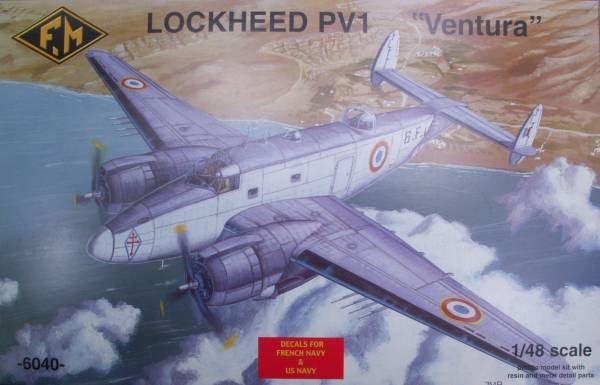
The Foundrie Miniatures kit comes in a fairly large top open two part box befitting the size of the contents. The top is thin but the bottom is heavier corrugated cardboard. Inside the box is one large bag that contains all of the injection molded parts which are molded in two colors. There are three sprues of white parts that covers most of the main airframe parts and two gray sprues with the balance of parts such as wheels, propellers, landing gear doors, cowlings and a few other odds and ends. The surface detail is recessed. The panel lines vary a bit and may need to be re scribed to look uniform in some places. The surface has a slight gloss to it but it has a texture to it that is common to a lot of limited run kits and it needs to be sanded for a smooth finish. This is not as bad as some kits and a light sanding should take care of it. Other than the rough finish I found only one sink mark near the nose of one fuselage half and no other notable surface defects although many of the parts were heavily flashed. The fuselage, wing and tail halves will need to be sanded on a flat surface both to smooth the mating surfaces and to reduce their thickness. In the case of the fuselage enough to match the cockpit canopy width and in the case of the wings to match the fuselage wing root size. There were no ejector pin marks to be found anywhere, not even the insides of the gear doors which have nice structure detail. The tires are weighted. Altogether there are 48 parts molded in white and gray. See photos below.
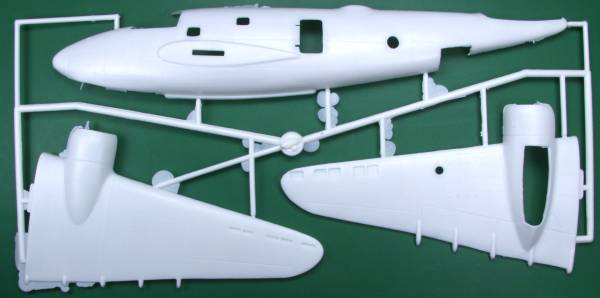
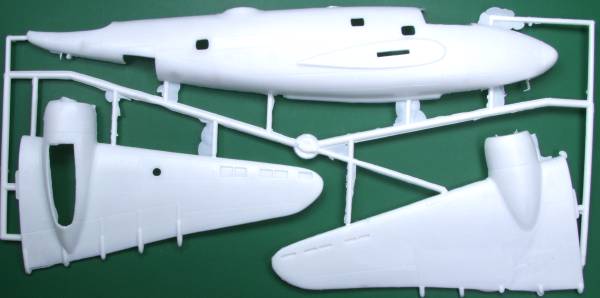
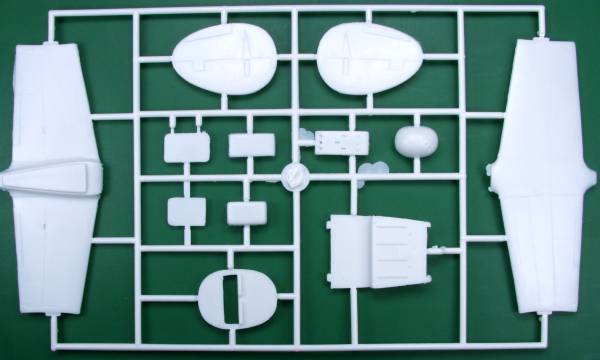
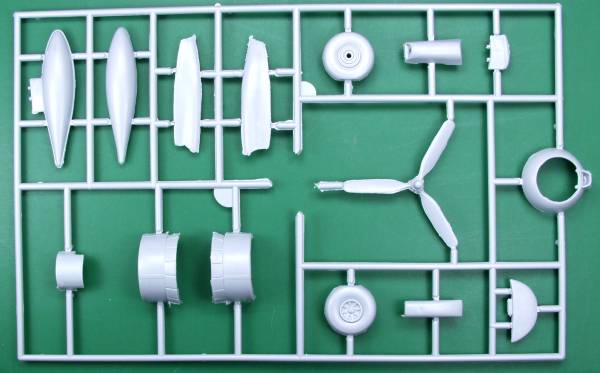
The clear parts are provided vacuformed for the cockpit, turret, astrodome and nose glass. The fuselage windows are injection molded. The vacuformed parts are clear but seem to have a slight texture to them. The frame lines are well defined and they should look OK with a coat of future. A duplicate set is provided in case of accidents. The injection molded parts are not as clear and and have a definite texture on them. Other reviews indicated they don't fit well either so some substituting may be the order of the day. Altogether there are 18 clear parts provided. See photos below.
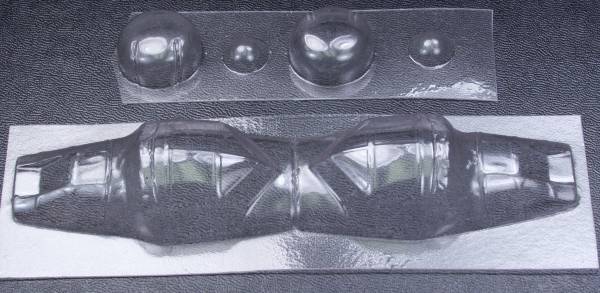
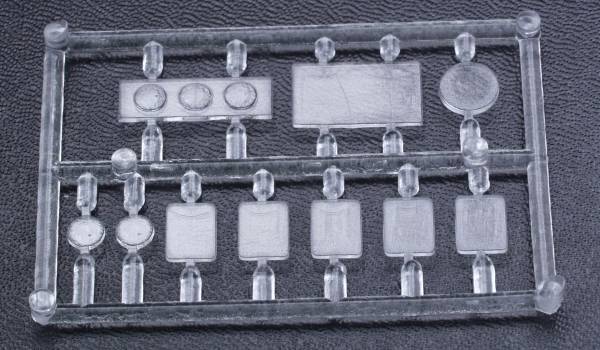
The kit supplies two small zip lock bags full of cast metal detail parts and these include main gear struts, crew seats, control columns and wheels, rudder pedals, DF loop antenna, Mk VI radar antenna, engine oil coolers, miscellaneous antennas, torque scissors, machine guns and barrels and rocket launcher rails. Most of the parts are nicely molded with minimal flash. Some parting lines will need to be cleaned up. The main gear includes molded on brake lines. Altogether there are 40 cast metal parts. See photos below.
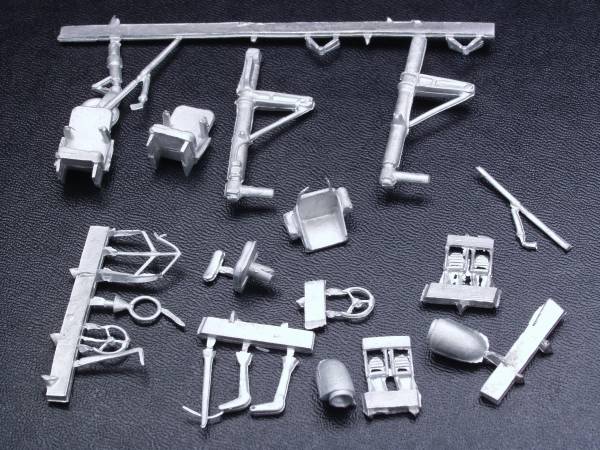
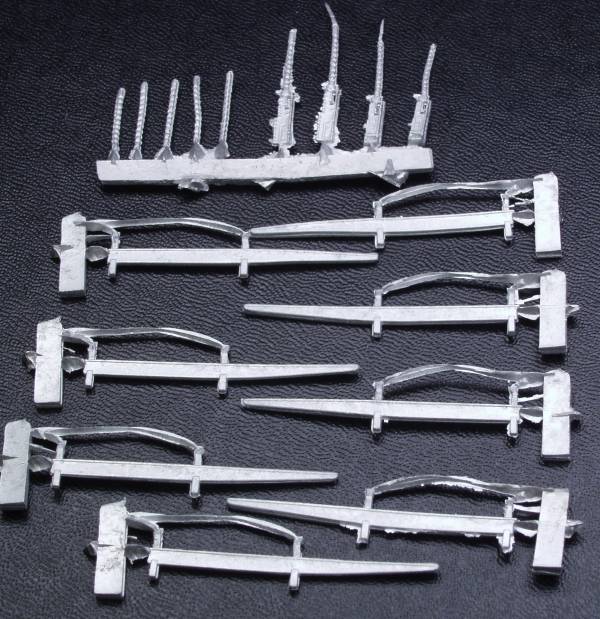
The engines, contained in a separate zip lock bag are a combination as resin crankcase housings and cast metal cylinders. The cylinders will take a while to clean up the flash and holes are molded in the crankcase for push rods on the front bank of cylinders. Nothing in the instructions on assembling these so a good photo of a P & W R2800 would be helpful in assembling and detail them. There are lots of extra cylinders provided, a total of 40 plus the two resin crankcases for a total of 42 engine parts. See photo below.
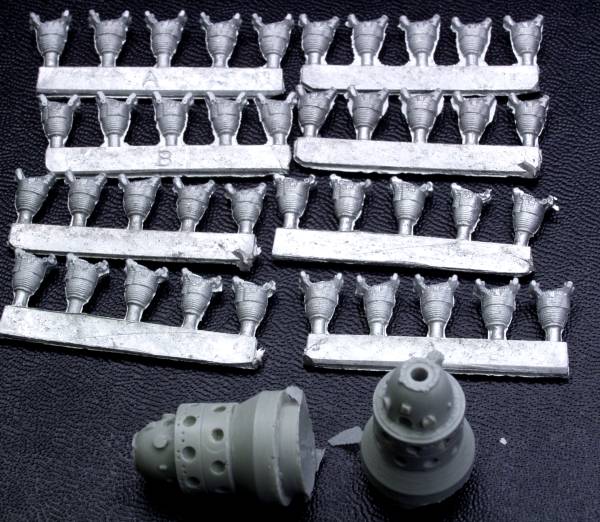
Yet another zip lock bag contains the resin parts which consists of two nicely done main gear bays with an oil tank and structural detail molded in. Also included are cockpit bulkheads, sidewalls, instrument panel with throttle quadrant, the turret base and two shrouded exhaust stacks for the night fighter version. The parts are nicely molded with only a thin bit of flash and no pour block to remove. I found no air bubbles or voids. The only gripe one might have is that the side walls show insulation matting installed and according to my sources this was not used on the PV-1's. A total of 10 resin parts. See photo below.
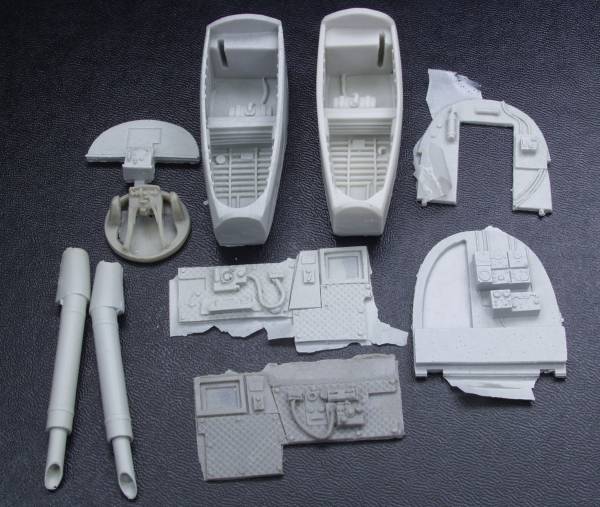
The kit supplies a single small fret of photoetch parts that includes an instrument panel, seat harnesses and belts, throttle levers and two mystery parts. There is no film for the instrument panel and the piece it mounts to has no instrument detail so you are on you own for those, see photo below. 19 photoetch parts bring the grand total for the kit to 177 parts.
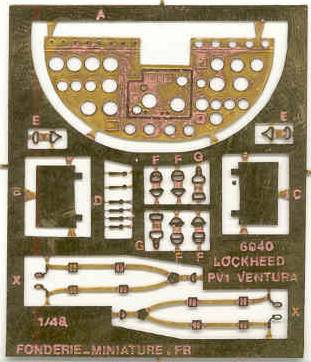
The decals seem to be an after thought. They provide markings for a French and U.S. Navy version with some artwork and mission markings but no stenciling although photos of the period show little in the way of stencil markings. The decals appear thin. The French national markings were not in register but most everything else looked OK. See below.
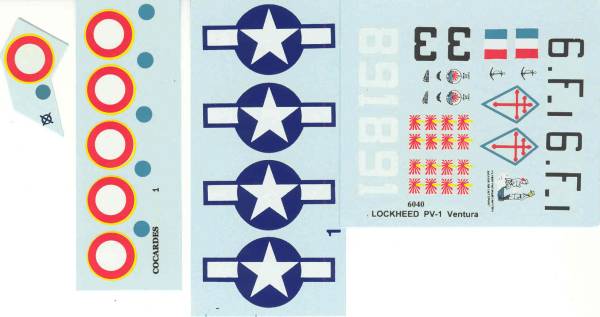
The instructions are a big let down. Two A4 size pages folded in half and printed on both sides forming eight small pages. The first page has the history in French. Four pages have assembly information in diagrams and notes in French with English translations. The center two pages have profiles showing painting and marking instructions. The last page has some more French, not sure what about and a list of colors by name and FS number for the Navy version. Other than diagrams and brief notes there is little information about the various versions.
After Market Goodies
One might ask with all the goodies supplied in the kit why do you need any aftermarket ? Well, that was my sentiments as well until I started the kit. One of the first things I tackled was the engines and while they looked decent, I found that the pushrod holes were not placed all that accurately and even cleaned up the cylinders didn't look all that good. Just for the heck of it I got out one of my Vector R2800 and did some assembly on it and I found it would not only fit but looked so much better I decided to use them instead of the kit parts. I had purchased the Vector engines to use on the P-61 but knew they would be a bear to fit in the P-61, so I decided to use them on this kit and buy the Quickboost engines for the P-61 as I knew those would fit. The Vector engines are kits in themselves and are real jewels. The vector number for the R2800 is [48003]. See photo below.
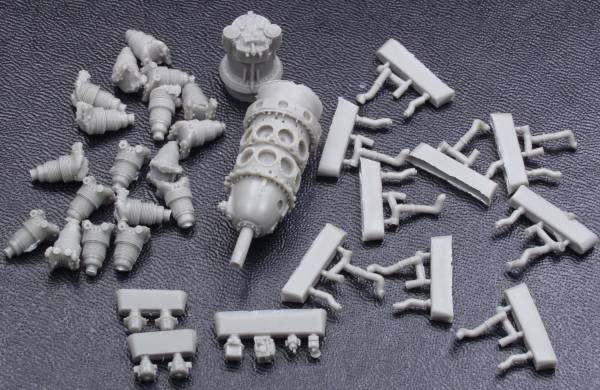
Conclusions
This is a limited run kit with all that goes along with typical short run kits such as rough surface finish, though not as bad as many, no alignment pins and the need to do much fitting and filing and clean up work on the parts. On the other hand it does include some really nice resin interior parts and cast metal parts for critical things like gear struts so it should build into a real beauty with a bit of TLC. It's also the only injection molded kit in this scale however Koster did make a vacuformed version. Due to the rather poor instructions additional references are good investment. If you are just interested in detail and marking information the "In Action" book below will provide the most detail of the references listed. The other three are nice and include much more in the way of history and text. I can't recommend this kit to anyone now that Revell has released their new kit. I didn't get far on my build as getting the gear bays to fit the wings required thinning the top surfaces of the wings to the thickness of paper. Also the wing tabs for fitting them to the fuselage were off so far as to be almost unuseable. I gave up at that point and put the kit on the permanent shelf of doom. From other sources I have learned that the interior parts supplied don't fit either so this kit gets two thumbs down from me. I can only assume that the person who built the kit in the link belowe is either much more talented, patient or a glutton for punishment in order to achieve the result he did and I believe he glossed over most of the issues involved in building the kit.
Links to kit build or reviews
A review / build can be found here.
References
PV Ventura / Harpoon Units of World War 2 by Alan C. Carey
The Empire Express by Charles L. Scrivner
PV-1 Ventura in Action by Charles Scrivner and Capt. W.E. Scarborough, USN (Ret.)
Vega Ventura, The operational History of Lockheed's Lucky Star by John C. Stanaway
Back to the No Longer in Queue page
Updated 1/3/14